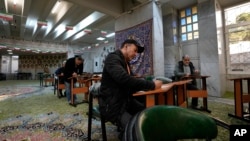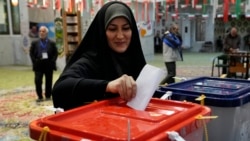Iran’s claimed 41% turnout for its March 1 elections, while a record low, is typical of figures used by authoritarian regimes to legitimize uncompetitive votes, the head of a European nonprofit group that researches the Iranian public’s attitudes told VOA this week.
In a televised Monday press briefing, Interior Minister Ahmad Vahidi said 25 million of 61 million eligible voters cast ballots in the elections for the parliament and the Assembly of Experts, which chooses Iran’s supreme leader. A pre-election survey by a government polling agency had predicted the same 41% turnout rate, which is one point below the previous record low of 42% set in the last parliamentary election in 2020.
Ultraconservative Islamists loyal to Supreme Leader Ayatollah Ali Khamenei won most seats in the two bodies after facing little competition from other establishment factions, which were largely disqualified from running by a pro-Khamenei vetting body. A broad political spectrum of opposition groups and activists inside and outside Iran had called for a boycott of the elections, which they described as a sham.
GAMAAN, a Netherlands-based research group, found in its own pre-election survey of 58,000 adults in Iran that 77% of respondents did not plan to vote. Many Iranians have been preoccupied with rapidly rising living expenses, reflecting inflation rates as high as 70% for housing and food in urban areas, according to state media.
U.S. State Department spokesman Matthew Miller told reporters Monday that Iranian authorities’ claims about election turnout have “generally been unreliable.”
GAMAAN director Ammar Maleki, a political science professor at the Netherlands’ Tilburg University, discussed the rationale behind Iran’s 41% election turnout figure in this week’s edition of VOA’s Flashpoint Iran podcast.
The following transcript of Maleki’s March 4 interview has been edited for brevity and clarity.
VOA: How credible is the 41% turnout number?
Ammar Maleki, GAMAAN: Let me give you some context. The 40% to 45% range is what I call the golden turnout for authoritarian regimes. In 2018, Venezuelan President Nicholas Maduro blocked his rivals from competing in the presidential election, and consequently, opposition leaders boycotted it. Based on independent observers, the election had a 26% turnout. But the formal number the regime announced was 46%.
The same year, Egypt held a presidential election under President Abdel-Fattah el-Sissi. In that election also, there were widespread boycotts by different groups. In the end, the authorities announced a 41% turnout. So, 41% is in line with elections that we see in such regimes.
That number also is consistent with what Iran’s official public opinion polling agency ISPA predicted two days before the elections: an expected turnout of about 41%.
VOA: Why is it desirable for Iran and those other governments to publicize a turnout percentage in the low 40s?
Maleki: It should be a number that you can sell. You might ask, why don’t they declare a turnout of 60% or 80%? In political science, we examine different types of authoritarian regimes, such as those that stage competitive elections and those that wield absolute power like North Korea and Iraq under former dictator Saddam Hussein. It was common for absolute authoritarian regimes to announce election victories with 99% of the vote, but this is not convincing anymore. If you are a wise authoritarian system, you know that in free democracies, election turnout normally does not exceed 80%. If you say that about 40% of your electorate voted, you can claim that half of your people are happy and half are not happy. And it would not be abnormal.
In that way, authoritarian regimes that want to show the world they have competitive elections can claim legitimacy. So when the Islamic republic’s authorities go on international media or participate in international forums and conferences and are asked about the elections, they can say: “We know that there is some dissatisfaction, but 41% is not bad,” and so on.
VOA: Based on what you saw in Iranian state media and in reports coming from citizen journalists in Iran, what is your best estimate of the actual election turnout?
Maleki: This is hard to answer. We might try to measure it in the next GAMAAN survey by asking people: “Did you vote or not?” And then we can have a more accurate number.
But I talked with an activist inside Iran yesterday, and he said it appears that in the country as a whole, the turnout could not have been more than 15, 16%, while in Tehran, it was around 8 or 9%. This is in line with GAMAAN's pre-election survey, which found that only 16% of respondents intended to vote. If we assume that all those who were undecided about voting [amounting to 8% of survey respondents] actually voted, the turnout could not have been more than 25%.
On the other hand, overseas observers and citizen reporters noted that on Iran’s election day, you could see that not too many people were at the voting stations and the streets were quiet. So all these observations indicate that Iran’s 41% turnout figure was fabricated and predetermined before the elections.











